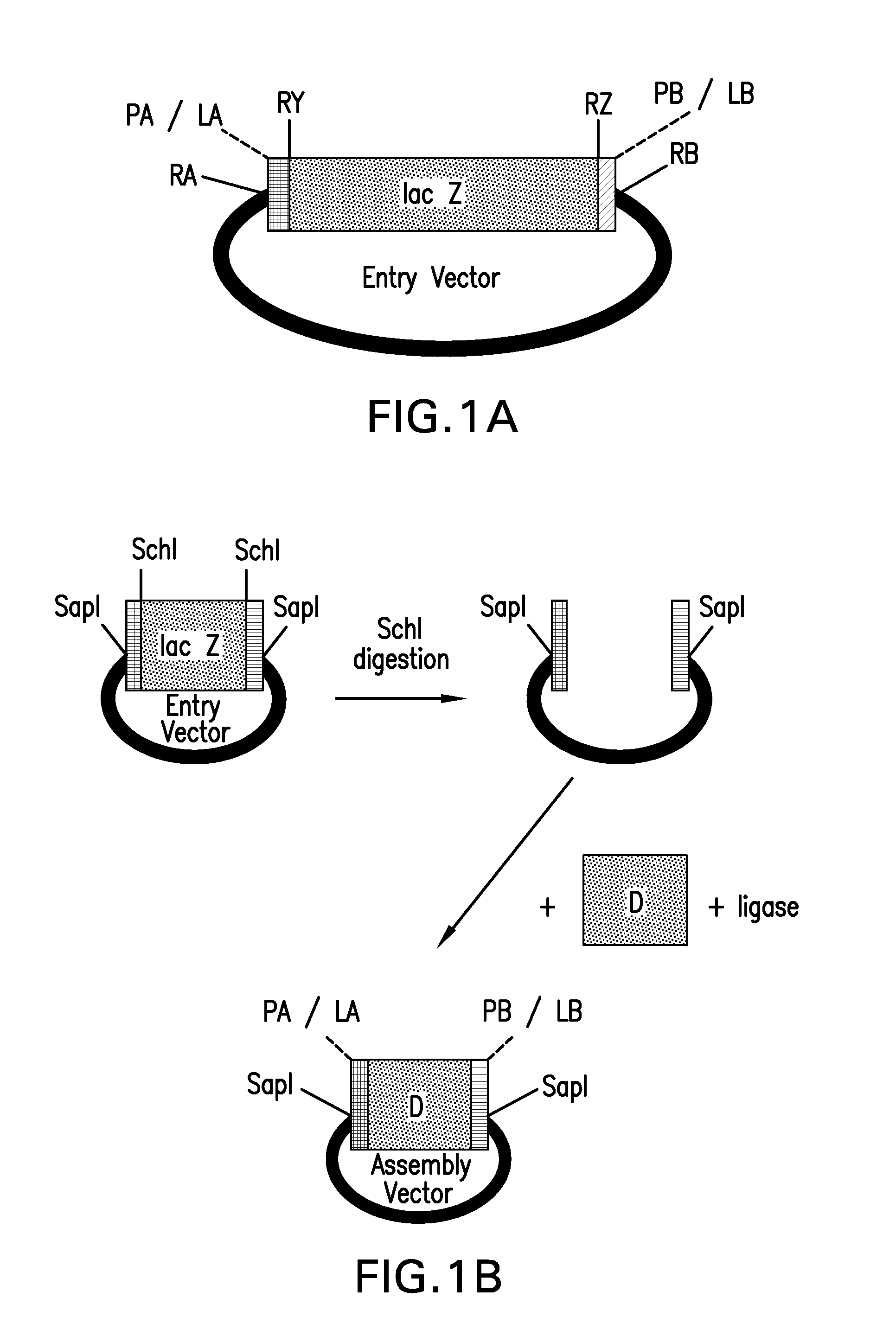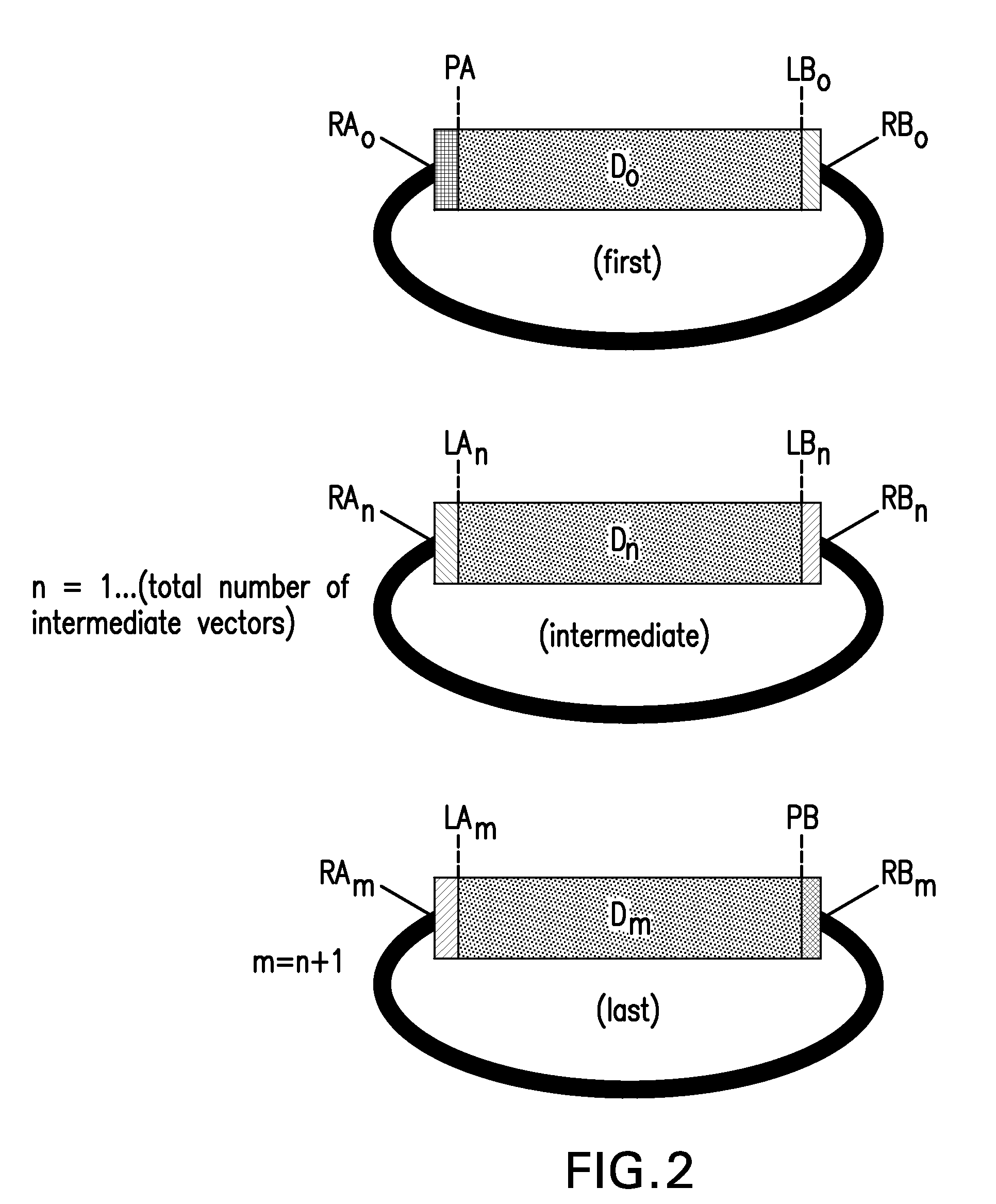Compositions and methods for the assembly of polynucleotides
a polynucleotide and polymerase technology, applied in the field of recombinant dna technology, can solve the problems of limiting the efficiency of restriction-enzyme based cloning methods, time-consuming and laborious, and affecting the structure and function of desired gene products,
- Summary
- Abstract
- Description
- Claims
- Application Information
AI Technical Summary
Benefits of technology
Problems solved by technology
Method used
Image
Examples
example 1
[0219]This example describes methods for making pRYSE vectors. pRYSE vectors comprise, in a 5′ to 3′ orientation, a first SapI restriction enzyme recognition site, a first annealable linker sequence or primer binding segment, a first SchI restriction enzyme recognition site, a green fluourescent protein (GFP) or lacZ marker gene, a second SchI restriction enzyme recognition site, a second annealable linker sequence or primer binding segment, and a second SapI restriction enzyme recognition site.
[0220]A DNA fragment encoding β-lactamase was PCR amplified from the pUC19 vector (GenBank accession L09137) using primers JCB158-17C (SEQ ID NO: 229) and JCB158-17D (SEQ ID NO: 230) after the SchI restriction enzyme recognition site in the bla gene of pUC19 had been removed by site-directed mutagenesis of pUC19 using PCR primers JCB158-17A (SEQ ID NO: 227) and JCB158-17B (SEQ ID NO: 228). The PCR product was gel purified, and then ligated into the TOPO vector (Invitrogen, Carlsbad, Calif.), ...
example 2
[0224]This example describes alternative methods for making pRYSE vectors.
[0225]pRYSE vectors 1 through 15 can be generated synthetically using as template SEQ ID NOS: 207 through 221 (e.g., by Biosearch Technologies, Novato, Calif.). Additional pRYSE vectors comprising different annealable linker sequences can be generated synthetically using as template SEQ ID NO: 221 in which the Pme1-5′ primer binding segment and / or the RYSE 1 annealable linker sequence are changed to another suitable annealable linker sequence or primer binding segment (see Table 1).
example 3
[0226]This example describes methods for making a pMULE vector, comprising, in a 5′ to 3′ orientation, a first SapI restriction enzyme recognition site, a first SchI restriction enzyme recognition site, a lacZ marker gene, a second SchI restriction enzyme recognition site, and a second SapI restriction enzyme recognition site. The pMULE vector can be used to clone Mules.
[0227]The backbone of pRYSE vector 8 was PCR amplified using primers K162 (SEQ ID NO: 109) and K163 (SEQ ID NO: 110). The reaction mixture was resolved by gel electrophoresis, and the approximately 2.2 kb vector backbone was gel purified. A DNA fragment comprising the lacZ gene was generated by digesting to completion pRYSE vector 8 using SchI restriction enzyme, heat inactivating the enzyme at 65° C. for 20 minutes, resolving the reaction mixture by gel electrophoresis, and gel purifying the approximately 0.5 kb DNA fragment. The purified DNA fragment comprising the lacZ gene was ligated with the purified vector bac...
PUM
 Login to View More
Login to View More Abstract
Description
Claims
Application Information
 Login to View More
Login to View More - R&D
- Intellectual Property
- Life Sciences
- Materials
- Tech Scout
- Unparalleled Data Quality
- Higher Quality Content
- 60% Fewer Hallucinations
Browse by: Latest US Patents, China's latest patents, Technical Efficacy Thesaurus, Application Domain, Technology Topic, Popular Technical Reports.
© 2025 PatSnap. All rights reserved.Legal|Privacy policy|Modern Slavery Act Transparency Statement|Sitemap|About US| Contact US: help@patsnap.com



